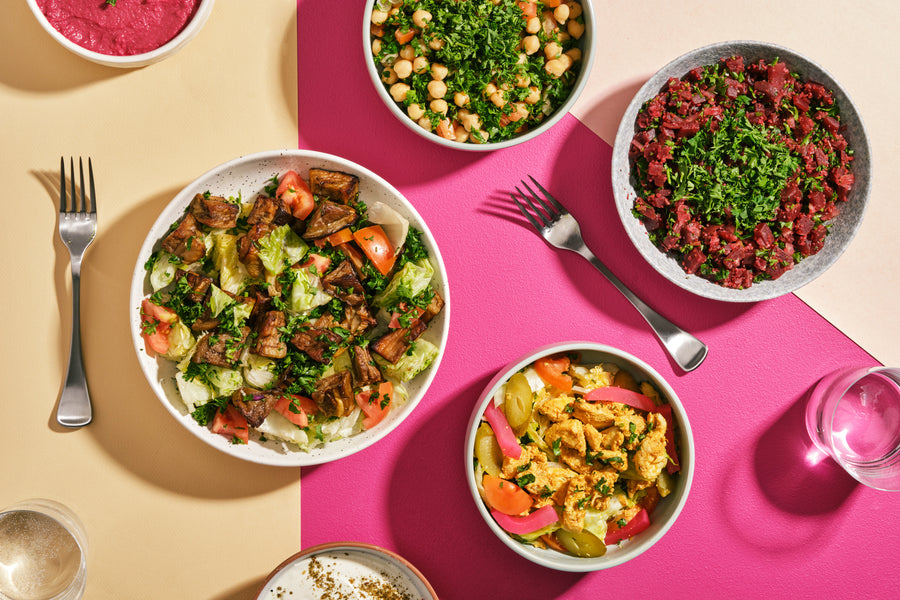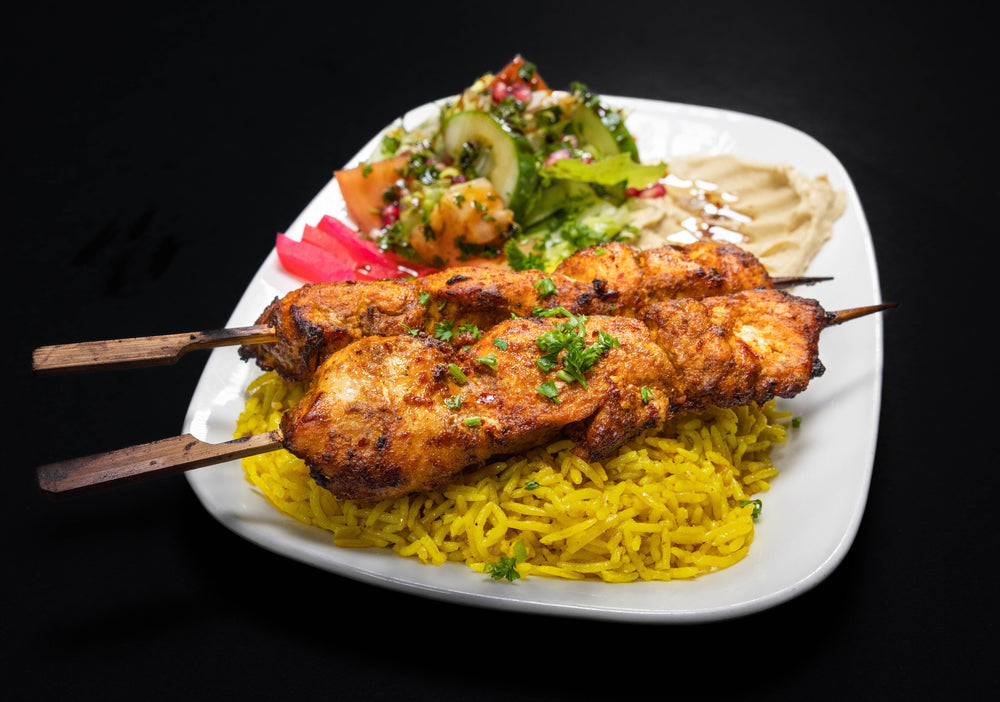All About the Rich Flavors and Traditions of Syrian Food: A Culinary Trip
Syrian food provides an one-of-a-kind blend of flavors and traditions that mirror its abundant social background. With staple components like olive oil and garlic, alongside a selection of flavors, the meals are both diverse and welcoming. From the detailed preparation of kibbeh to the pleasant appeal of baklava, each element of this cooking landscape reveals deeper tales. As one explores the essence of these flavors, a higher understanding of public dining and celebration emerges.
The Essence of Syrian Active Ingredients
The essence of Syrian active ingredients exists in their rich variety and ingrained social relevance. Influenced by the country's varied location and background, Syrian cuisine integrates a large range of seasonings, herbs, and fresh fruit and vegetables. Staples such as olive oil, garlic, and lemon offer a structure, while spices like coriander, sumac, and cumin add deepness and complexity to dishes.The use fresh herbs, consisting of parsley and mint, highlights the value of seasonal active ingredients. Additionally, the area's abundant soil yields an abundance of veggies and fruits, such as eggplants, pomegranates, and tomatoes, which are important to many recipes. Grains like bulgur and rice create the base of lots of meals, highlighting the importance of these components in Syrian culture. This mix of flavors mirrors not simply a cooking practice but also a tapestry of historic impacts, making Syrian ingredients essential to comprehending its food's vibrant personality.

Iconic Dishes of Syrian Cuisine
Syrian food is renowned for its famous dishes that showcase a rich tapestry of tastes and structures. Conventional meze plates provide a variety of little meals that tantalize the palate, while hearty main dishes supply rewarding focal points for meals (Afternoon Tea Vancouver). To complete the experience, a choice of scrumptious desserts adds a pleasant note to the cooking trip
Standard Meze Plates

Hearty Key Courses
Hearty main dishes work as the centerpiece of Syrian eating, showcasing a mix of flavors that show the country's abundant culinary customs. Recipes such as kebab hindi, featuring seasoned lamb skewers, and the renowned mujaddara, a comforting mix of lentils and rice, highlight using fresh components and fragrant spices. Another staple is the iconic kibbeh, made from bulgur wheat and minced meat, usually offered in numerous forms, including baked, deep-fried, or raw. In addition, the flavors of the land come to life in recipes like stuffed veggies, called mahshi, which are full of rice, meat, and herbs. These main dishes not just please cravings yet additionally tell stories of family members celebrations and social heritage.
Delightful Treats Option
A delightful selection of desserts defines the pleasant side of Syrian food, offering a tantalizing end to any type of meal. Amongst the most well known confections are baklava, delicate layers of phyllo pastry loaded with nuts and drenched in syrup, and maamoul, shortbread-like cookies frequently stuffed with dates or nuts. Knafeh, a rich dessert made from slim noodle-like bread taken in syrup and layered with cheese, is a prominent selection, specifically throughout cheery celebrations. Furthermore, the wonderful and fragrant rice pudding, known as roz bil laban, gives a comforting finish. These scrumptious treats not only display the region's cooking know-how yet also show the social heritage of Syria, making them cherished treats in both restaurants and homes alike.
Traditional Food Preparation Methods
Although contemporary benefits have affected lots of culinary techniques, conventional cooking strategies stay vital to Syrian cuisine. These techniques commonly highlight using fresh, seasonal components and concentrate on slow food preparation to develop abundant flavors. Techniques such as cooking, braising, and stewing are common, allowing the natural tastes of the ingredients to radiate through.One notable technique is the prep work of kibbeh, a meal made from carefully ground meat and bulgur. It requires skillful hand-rolling right into different forms and can be baked, deep-fried, or served raw. Furthermore, the art of making bread, especially pita, is main to lots of meals, typically cooked in a traditional rock oven.Preservation methods like pickling and fermenting additionally play a vital role, enhancing the diversity of tastes look at this web-site found in Syrian dishes. These methods not only reflect the region's agricultural heritage however likewise promote a strong sense of neighborhood with shared culinary methods.

The Role of Spices in Flavor
Flavors function as the heartbeat of Syrian food, instilling meals with complex tastes and fragrant depth. Each seasoning plays a pivotal duty, contributing not just to preference yet likewise to the social heritage of the region. Typically used seasonings consist of coriander, sumac, and cumin, each providing an one-of-a-kind profile that elevates standard dishes. For example, cumin offers heat and earthiness, while sumac adds a tasty illumination, enhancing the general dish.Syrian cooks often blend seasonings to produce harmonious accounts, mirroring the intricate equilibrium of tastes that specify the food. Using seasonings is not just for seasoning; it also offers to maintain food and boost its nutritional value. This thoughtful incorporation highlights a deep understanding of the cooking arts, where seasonings come to be essential writers, communicating the rich history and diverse impacts that characterize Syrian gastronomy. Ultimately, flavors are crucial in crafting genuine and remarkable Syrian dishes.
Festive customs and celebratory meals
Congratulatory dishes in Syrian cuisine are noted by standard feast dishes that reflect the nation's abundant culinary heritage. Unique events commonly include one-of-a-kind rituals that boost the communal experience of eating. These custom-mades not just recognize the significance of the events however additionally reinforce domestic and cultural bonds.
Typical Feast Dishes
When family members gather to celebrate considerable events in Syria, traditional banquet dishes take spotlight, showcasing the rich culinary heritage of the area. These gatherings frequently include lively plates of mezze, including hummus, baba ghanoush, and tabbouleh, which offer as delightful starters. The main program generally highlights lamb or hen, seasoned and cooked to excellence, typically come with by fragrant rice pilaf or bulgur. Among one of the most beloved meals is maqlooba, a split rice recipe with veggies and meat, flipped upside down prior to serving. Desserts likewise play a vital function, with baklava and knafeh offering a pleasant finish to the dish. Each recipe not just delights the taste buds however additionally reflects the ingrained practices and communal spirit of Syrian culture.
Unique Celebration Routines
Special events in Syria are noted by abundant routines that link food and festivity, mirroring the social relevance of communal gatherings. Congratulatory meals frequently include typical dishes such as kibbeh, tabbouleh, and numerous barbequed meats, prepared with treatment and shared amongst friends and family. Throughout spiritual holidays like Eid al-Fitr and Eid al-Adha, households come together to prepare unique desserts like maamoul, signifying unity and joy. Weddings go to this website are especially fancy, featuring several programs and vivid displays of hospitality. These events are not merely about food; they encompass music, dancing, and storytelling, strengthening social bonds and cultural heritage. Via these rituals, Syrians celebrate life's milestones, making certain practices are passed down with generations, enriching their culinary landscape.
The Significance of Sharing and Neighborhood
Sharing dishes is an essential element of Syrian society, showing the deep-rooted worths of area and link. In Syria, food is not just sustenance yet a method of bringing individuals together. Friends and families collect around the table to enjoy typical meals, fostering bonds and developing enduring memories. This common dining experience stresses hospitality, where hosts most likely to wonderful lengths to ensure every visitor feels invited and nourished.The act of sharing food also signifies generosity and solidarity, reinforcing social ties within areas and larger areas. During celebrations, it prevails for individuals to offer each other, showcasing a spirit of togetherness that goes beyond individualism. Parties, whether small or big, are usually noted by the sharing of dishes, where diverse flavors and recipes collaborated, reflecting the rich tapestry of Syrian society. As necessary, the value of sharing and community in Syrian cuisine is not only a cooking custom yet a critical social method.
A Cooking Exploration of Syrian Desserts
Commonly eclipsed by mouthwatering meals, Syrian desserts hold a cherished place in the country's cooking heritage (Afternoon Tea Vancouver). These confections mirror the area's abundant history, blending tastes and strategies from numerous societies. Conventional desserts like baklava, with its layers of phyllo bread, nuts, and honey syrup, display the creativity involved in Syrian food preparation. Ma'amoul, a shortbread-like cookie full of days or nuts, is usually prepared for joyful events, symbolizing hospitality and celebration.Another beloved wonderful is Knafeh, a pastry saturated in syrup and layered with cheese or lotion, supplying a delightful comparison of structures. Syrians likewise appreciate a selection of fruit syrups and protects, typically served with tea or as component of a bigger spread during celebrations. These sugary foods not only satisfy the taste however likewise serve as a bridge between generations, preserving the customs and stories of Syrian culture through each savory bite
Regularly Asked Concerns
What Are the Health And Wellness Conveniences of Typical Syrian Foods?
The wellness advantages of traditional Syrian foods consist of rich nutrients from fresh vegetables, beans, and whole grains. These active ingredients advertise heart wellness, enhance digestion, and supply vital vitamins, adding to general well-being and a well balanced diet regimen.
How Has Syrian Food Developed Throughout The Years?
Syrian cuisine has advanced significantly, affected by historical trade routes, cultural exchanges, and regional accessibility of components. Traditional dishes have actually incorporated modern tastes and strategies while preserving their rich heritage, mirroring a varied culinary landscape.
Are There Vegetarian or Vegan Options in Syrian Cuisine?
Syrian cuisine uses numerous vegetarian and vegan alternatives, including meals like falafel, tabbouleh, and stuffed grape fallen leaves. These meals highlight the region's rich agricultural heritage, showcasing fresh veggies, grains, and aromatic flavors in lively combinations.
What Beverages Set Well With Syrian Recipes?
When considering drinks that enhance Syrian recipes, one could find that mint ayran, tea, and pomegranate juice enhance the dish's flavors. In addition, red white wine frequently sets well with the spices commonly discovered in these foods.
How Can I Recreate Syrian Dishes at Home?
To recreate Syrian meals in your home, one must check out authentic recipes, collect traditional components, and use cooking techniques unique to the food. Try out flavors and presentation also boosts the general dining experience. Syrian cuisine is renowned for its iconic dishes that display an abundant view it now tapestry of tastes and textures. Flavors serve as the heart beat of Syrian cuisine, instilling meals with complicated flavors and aromatic deepness. Celebratory meals in Syrian food are noted by conventional feast dishes that reflect the country's rich culinary heritage. Parties, whether big or small, are frequently noted by the sharing of meals, where diverse tastes and meals come together, showing the rich tapestry of Syrian society. Syrian cuisine supplies various vegan and vegan choices, including meals like falafel, tabbouleh, and stuffed grape fallen leaves.